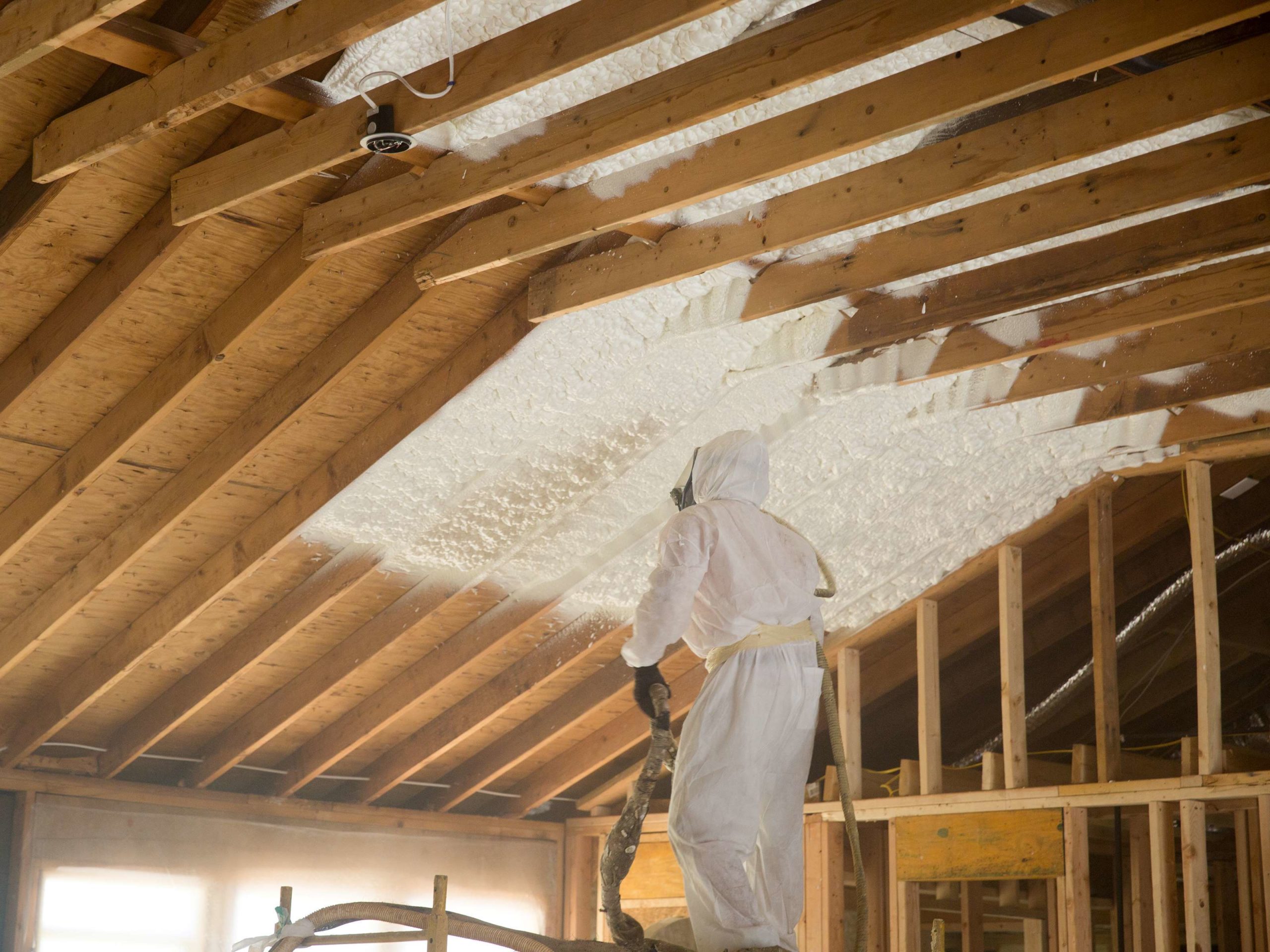The Environmental Impact of Spray Foam: Sustainability Considerations
Wiki Article
Spray Foam: The Ultimate Solution for Air Sealing and Insulation
Spray foam insulation has actually become a leading solution for effective air sealing and thermal insulation, supplying an unique mix of properties that establish it in addition to traditional approaches. Its capability to increase and load spaces makes it specifically effective in protecting against air leak, which can considerably impact energy effectiveness. Nevertheless, comprehending the complete scope of its benefits, setup procedures, and comparisons with other insulation kinds is critical for making educated choices. As we check out these elements, the effects for both brand-new building and constructions and retrofits come to be significantly substantial. What variables should affect your selection?What Is Spray Foam?
Spray foam is a versatile insulation product that combines the principles of air sealing and thermal resistance to enhance power effectiveness in buildings. Composed mainly of polyurethane or other comparable compounds, spray foam is used as a liquid that expands upon call with surfaces, creating a strong, constant layer of insulation. This unique building permits it to fill up gaps, cracks, and gaps that standard insulation materials might ignore, offering an exceptional air seal.There are two major sorts of spray foam: open-cell and closed-cell. Open-cell spray foam is lighter and a lot more flexible, supplying exceptional sound absorption and a lower R-value per inch - Spray Foam. On the other hand, closed-cell spray foam is denser, providing a higher R-value, dampness resistance, and included architectural stability to building parts
The application process usually involves specific tools, making sure a seamless application that complies with numerous substrates, including concrete, metal, and wood. This flexibility makes spray foam suitable for both brand-new buildings and retrofitting existing frameworks. Its capacity to create a closed obstacle substantially adds to decreasing energy intake and improving indoor air top quality, therefore making it a preferred choice among building contractors and homeowners alike.
Benefits of Spray Foam Insulation
One of the most significant advantages of spray foam insulation is its exceptional ability to produce a constant air barrier, which properly reduces energy loss. Unlike standard insulation materials, spray foam broadens to fill up splits and spaces, making sure that air leakage is considerably minimized. This characteristic not just boosts energy effectiveness but likewise brings about decrease energy bills with time.
Additionally, spray foam insulation supplies remarkable thermal resistance, adding to a more secure indoor setting. Its high R-value per inch permits effective insulation in restricted rooms, making it excellent for attic rooms, walls, and crawl spaces. Furthermore, the moisture-resistant residential or commercial properties of spray foam assistance avoid mold and mold growth, promoting healthier living problems.
Another vital benefit of spray foam insulation is its sound-dampening top qualities (Spray Foam). It successfully decreases sound transmission between areas, producing a quieter and more comfy home atmosphere. The toughness of spray foam likewise attracts attention, as it does not sag or resolve gradually, maintaining its performance throughout its lifespan
Just How Spray Foam Works
Recognizing how spray foam insulation functions is important for valuing its effectiveness in air securing and thermal resistance. Spray foam insulation includes 2 primary elements: isocyanate and polyol material. When these components are blended, they undertake a chain reaction that creates the material to broaden swiftly, creating a dense foam that loads gaps, cracks, and dental caries.As the foam broadens, it complies with surface areas, forming an airtight seal that significantly decreases air seepage. This particular makes spray foam insulation very efficient at preventing drafts and dampness infiltration, which can lead to energy loss and damage in time. Additionally, the closed-cell variation of spray foam supplies superior thermal resistance due to its rigid structure, successfully decreasing heat transfer.
The distinct residential or commercial properties of spray foam enable it to adapt uneven surface areas, making sure thorough insurance coverage and a seamless barrier. Therefore, spray foam insulation not only boosts power efficiency yet also contributes to enhanced interior air quality by lowering the accumulation of allergens and pollutants. Eventually, comprehending the technicians behind spray foam emphasizes its role as a remarkable option for insulation and air securing in both business and domestic applications.
Installation Refine Summary

Before setup, the area must be properly cleaned and prepped, guaranteeing that surfaces are without moisture, dust, and debris. This action is crucial since impurities can endanger attachment and overall performance. Once the area is prepared, the application involves blending both parts of the spray foam, which expands upon call and fills spaces efficiently.
Trained professionals need to conduct Recommended Reading the installment, utilizing specialized tools to make certain consistent protection and optimal density. Safety safety measures, consisting of wearing protective gear and making certain appropriate air flow, are imperative throughout this procedure. After application, the foam normally treatments rapidly, creating a solid barrier that improves energy efficiency.
Contrasting Spray Foam to Standard Insulation
When evaluating insulation choices, spray foam insulation stands out in contrast to standard products such as fiberglass and cellulose. Unlike fiberglass and cellulose, which can permit air seepage, spray foam broadens upon application, filling gaps and spaces to create an impermeable seal.Furthermore, spray foam gives a greater R-value per inch than traditional insulation kinds, using even more effective thermal resistance in a thinner account. This particular is especially beneficial precede with restricted tooth cavity deepness. Spray foam is immune to wetness and mold development, which can be a substantial issue with cellulose and fiberglass, particularly in humid atmospheres.
However, spray foam insulation typically lugs a greater in advance cost than its conventional counterparts. Homeowners have to evaluate this first investment versus long-lasting energy cost savings and efficiency advantages. Ultimately, while both insulation types offer their objective, spray foam becomes an extra advanced remedy for modern-day insulation demands, especially in terms of air securing and thermal efficiency.

Final Thought
In summary, spray foam insulation represents a highly efficient solution for accomplishing optimal air securing and thermal resistance. Its special buildings, consisting of wetness resistance and sound dampening, make it appropriate for different applications in both new constructions and retrofitting projects (Spray Foam). The initial costs might be higher contrasted to traditional insulation materials, the long-lasting advantages, such as substantial power savings and enhanced interior air quality, validate the financial investment and emphasize its value in contemporary structure techniques.Spray foam insulation has emerged as a leading remedy for efficient air securing and thermal insulation, offering an one-of-a-kind mix of homes that establish it apart from company website typical approaches.Spray foam is a versatile insulation material that combines the concepts of air sealing and thermal resistance to enhance power effectiveness in buildings.When assessing insulation alternatives, spray foam insulation stands out in comparison to conventional products such additional resources as fiberglass and cellulose. Ultimately, while both insulation types offer their purpose, spray foam emerges as a much more innovative remedy for contemporary insulation needs, especially in terms of air sealing and thermal performance.
In summary, spray foam insulation stands for a very effective option for attaining optimum air securing and thermal resistance.
Report this wiki page